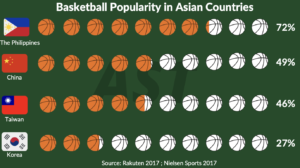
Photo Credit: Second Spectrum
This is the second article in our series on how sports tech will transform the future of sports in Asia at all levels – from grassroots youth sports, to elite player development to fan engagement. Last month we talked about Football tech and in this article, we will highlight why the basketball ecosystem in Asia needs digital transformation to help build the sport and accelerate the growth of the sports and the many national basketball leagues in Asia.
Basketball and its culture in Asia are immense and is currently in a position to see phenomenal growth and monetization opportunities by leveraging the latest sports tech. Introduced to Asia over a century ago, basketball is seeing huge growth from the grassroots to the professional ranks with several Asian countries having their own professional leagues. In addition to national federations, national leagues and sportswear brands, important players in Asia’s basketball ecosystem Asia include the NBA which has operated in Asia since establishing an office in Hong Kong in 1995, and FIBA which recently held the 2019 World Cup in China and will hold the 2023 World Cup hosted by Japan, The Philippines, and Indonesia.

Despite the huge interest and investment in the sport, there still remains a gap between the adoption of sport tech and basketball technologies in Asia compared with the US and Europe. This represents a huge opportunity to accelerate the development of the sport on many levels. For example, sports tech could be leveraged to improve the overall performance and global rankings of Asia’s national teams. According to FIBA’s official rankings, none of the Men’s Teams in Asia ranked in the top 10 globally and China is the highest ranked at number 27. One bright spot and an opportunity for growth is the women’s game with China and Korea ranked 6th & 7th respectively. Both countries did well at the Tokyo Olympics with Japan’s women’s team winning the silver medal in basketball and China’s women’s team winning the bronze in 3 x 3.

While there remain many challenges to the development of basketball in Asia, the growing popularity of the sport, the increased number of youth programs and academies, and the ongoing development and commercialization of Asia’s professional leagues present huge potential for the sport to grow even more.
Digital transformation is key
Asia is known to be an early adopter of technology and often leapfrogs other stages of development in many industries. A key question is how can Asian basketball leverage existing sports tech and basketball tech to enhance all elements of the game including youth development, elite training, fan and sponsor engagement to better promote the consumption of basketball and grow all revenues around the sport.
Grassroots youth basketball – nurturing next generation of local talents
Basketball and sports culture in Asia is very different compared with the West. For example, the US has a well-established system for student athletes with highly developed high school sports and college athletic programs such as the NCAA, and in Europe there is a very strong club system. In Asia, many schools don’t provide adequate sports training for students and one of the only ways that youth can access professional basketball training is through programs like the JR. NBA or through private programs and youth sports academies such as PacificPine Sports which operates in China and Hong Kong. The JR. NBA Program nurtures future fans and young players aged 8 years of age and up through enhancing coaching and building the basketball coaching ecosystem. The program has trained more than 72,000 coaches from 53,000 schools across 50 Asian cities and has reached over 24 million children. Due to Covid and to reach more coaches and players the program has recently shifted towards a more digital approach.
Another key element in basketball training is the integration of technology in the coaching process so that they can spend more time working directly with the athletes. In the US, many training academies have started using on-demand training platforms such as MaxOne, invested by Stadia Ventures & NBA Star Chris Paul that uses technology from his CP3 academy. The platform makes it easier for coaches to train, manage and communicate with their teams and players. For those that are unable to train in person with a coach there is a coaching platform called UpLift Labs that has an online system called Uplift Coach that allows coaches to remotely train players. Schools and training academies in Asia should consider investing in these types of digital solutions to enhance the youth training sports ecosystem.
*For additional information please read our previous article on digital coaching.
Elite basketball – players performance to league development
In elite sports such as basketball, the difference between winning and losing can often be found in monitoring and analyzing the data around a player’s health status, physical performance, mental well-being and game readiness. One platform that manages all individual player and team data is Kinduct, a well known digital athlete management system, that has powered several recent NBA Champions including the Los Angeles Lakers and the Golden State Warriors plus dozens of other NBA and NCAA teams. The platform integrates over 50 wearables and devices to help present a complete profile of the player to measure training, workload, recovery, rehab programs and also tracks injuries. RSPCT Basketball, is another technology used by NBA teams to help players to greatly improve their shooting precision. UpLift Labs, has another platform, called Uplift Capture which can record and measure the biomechanics of a player’s shooting motion using just two iPhones to optimize athlete performance.
All of these technologies used by NBA teams are currently available to federations, national teams, leagues and teams in Asia, however, the adoption rate to date is still very low which is puzzling given Asia’s usual quick adoption of technology. Ideally, we will see more adoption of these technologies to improve Asia’s basketball development and competitiveness at all levels.
Fan & sponsor engagement – broadcasting to digital collectibles
How sports are consumed is another key element to attract fans and generate revenues for leagues and teams. Accelerated by the pandemic, leagues around the world became even more innovative to stay connected with fans and developed innovations that are another significant opportunity for Asian leagues and teams to help build out their fan bases. New technology enables teams to bring fans closer to the game through more immersive viewing experiences. OTT platforms are now able to produce multiple feeds that focus on players, coaches, stats and data, fantasy league updates, betting odds and sponsor messages. Companies like Second Spectrum, recently acquired by Genius Sports, provide AR powered immersive experiences for fans whether you watch the game at home or at the stadium and these will become even more powerful when used with smartphones and with glasses. Another innovative company is Edisen.ai which is an AI-powered fan engagement platform that allows fans to tap on their mobile phone or click on any player on their computer during a live broadcast to access the player’s stats or purchase their jersey.
Stadium technology has also transformed during the pandemic and companies like FanCam with their CrowdIQ platform helps teams to improve their game day experience, optimize ticket sales and better communicate ROI to sponsorship partners. Stadium owners are able to understand who is sitting in the seats, what they are looking at during the game including the court, the scoreboard, their phone or the person sitting next to them including how much time is spent looking at each.
Digital collectibles and NFTs from companies like NBA Top Shot, could also unlock new value for Asia’s Leagues and teams and create new and interesting ways to interact with fans. There are already many companies in Asia that are active in this space and this will become even larger with the development of the metaverse that will definitely further revolutionize how sports are consumed in the future.
Who is one the players that may be the first to adopt these readily available technologies in Asia?
One organization with the potential to lead the change in transforming Asia’s basketball ecosystem by adopting new approaches and technologies is the East Asia Super League (EASL). Asia’s newest league, officially recognised by FIBA, brings together the top teams in Asia in annual championship with a format similar to Europe’s Champions League in football.
“Our vision for EASL is to create one of the top three basketball leagues in the world by 2025 and transform Asia’s basketball ecosystem through the adoption of cutting edge technologies and sports tech.”
Matt Beyer, CEO, East Asia Super League
From its inception EASL has taken a ‘digital first’ focus in everything they do including its emphasis on leveraging digital channels for broadcast and extensive use of social media platforms to create engaging unique content. This fresh approach is building a more direct and inclusive relationship with Asia’s regional basketball fans. EASL views digital transformation as a critical part of their strategy to build the league and transform Asian basketball at all levels.

There is clearly an opportunity for leagues in Asia to transform basketball by enhancing the fan experience in and out of the stadium, strengthening fan engagement, especially with Gen Z, who are digital-savvy and have high spending power, and ultimately add value to their offerings to generate greater revenues and build their leagues.
Conclusion
What has not taken place to date in Asian basketball is the large-scale adoption of sports tech and basketball tech that is readily available and already being used in many other parts of the world. Stakeholders in Asian basketball can leverage sports tech to increase youth participation, develop even better players to compete globally, and build stronger national leagues with more fan engagement and monetization opportunities. Ultimately, sports tech represents a great opportunity for Asian basketball to build on the huge popularity of the sport and transform the basketball ecosystem in the region and take Asian basketball to new heights.
AST has a track record of working with leading basketball leagues, teams and academies teams to leverage sports technologies and power digital transformation. If you’re interested to learn more, please read our Case Study on how AST provided a strategic plan that included digital transformation for one of China’s leading professional basketball teams. You can also Connect With Us here to start a discussion and learn more.






